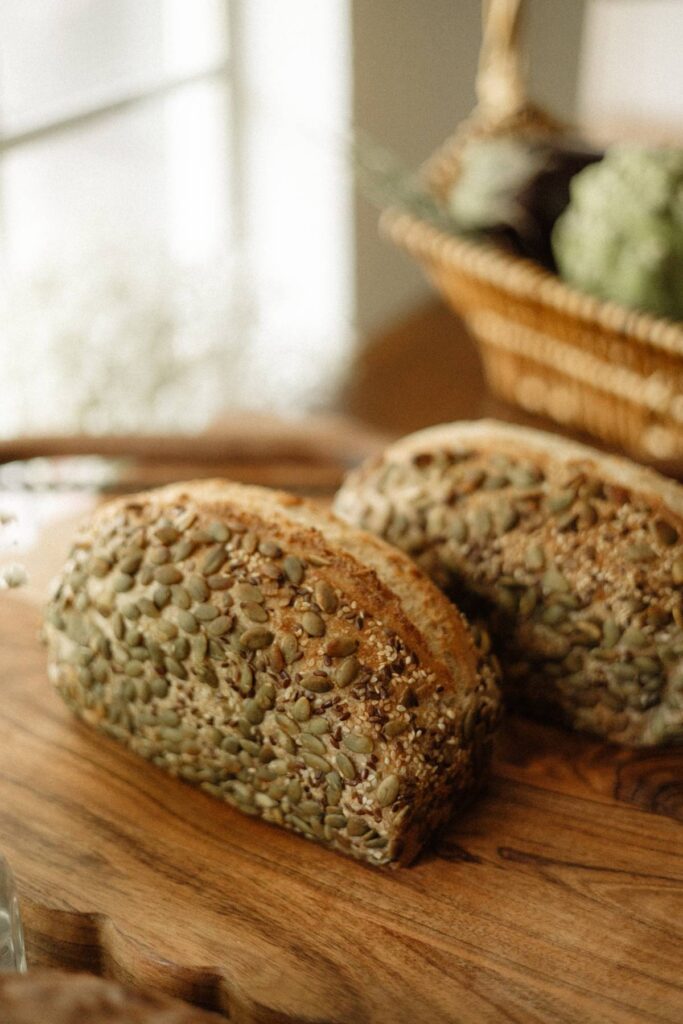
Early on in my cottage bakery journey, I knew I wanted to offer a hearty loaf to my customers. I’d watch bakers in England and Germany making these beautiful seed-coated loaves, often half whole wheat, and I couldn’t stop thinking about how real and nourishing they looked. I started experimenting with freshly milled grains and found that 40% organic spelt was the sweet spot. It added a rich, nutty depth without making the bread too heavy or too savory.
Thank you for reading this post, don't forget to subscribe!This ancient grain sourdough bread has become one of the most popular loaves at my cottage bakery, and for good reason. The crumb is soft and moist, the crust is rustic and flavorful, and it’s versatile enough for sandwiches, toast, or even rolls.
I use freshly milled spelt flour, but any whole wheat will work beautifully if that’s what you have on hand. It’s gentle on the gut, sturdy enough to slice, and has that wholesome flavor that makes sourdough feel like home.
Watch the video tutorial to see how I mix, stretch, and fold this dough step-by-step.
Ancient Grain & Seed Sandwich Loaf
Equipment
- Bulk Baking Kitchen Scale for bulk baking – this one has a 30kg/66lb capacity
- Grain Mill code SARAH for $20 off
- Food Thermometer to help ensure bread is fully baked through
Ingredients
- 50 grams bubbly, active sourdough starter (100% hydration) optional: use 100g for faster proofing time
- 365 grams warm filtered water
- 180 grams spelt flour
- 300 grams all-purpose flour (11%+ protein), or bread flour
- 20 grams honey
- 10 grams fine sea salt
- Mixed seeds for rolling (I use sesame, flax, sunflower, and pumpkin)
Instructions
- Mix. Combine your starter, water, flours, salt and honey. Mix by hand until no dry bits remain and let rest for 30 minutes.
- Stretch and Folds. Wet your hand to prevent sticking, gently grab one side of the dough, stretch it upward, then fold it over to the opposite side.Turn the bowl a quarter turn and repeat the motion. Continue until you’ve stretched and folded from all four sides.That’s one set. Cover the bowl and let the dough rest for 30 minutes before repeating.You’ll do this three times total, 30 minutes apart. Each set helps the dough become smoother, stronger, and more elastic. By the end, it should hold its shape better and feel lighter and puffier to the touch.
- Bulk Fermentation. Let the dough rest for the remainder of bulk fermentation, until it has roughly doubled in size (about 5hrs).
- Pre-shape and Rest. Turn out the dough and gently pre-shape it into a round or oval. Rest uncovered for 20–30 minutes.
- Final Shape & Coating. Shape into a sandwich loaf (see shaping technique in the video), then roll in a mix of seeds. If the seeds aren't sticking, lightly mist the surface of your dough with water and then roll in the seeds.Optional: shape into a batard and bake in a dutch oven for a boule shape.
- Proof. Place into a loaf tin, seam side down. Cover and cold-proof in the fridge overnight (8–12 hours). Although I highly recommend the overnight cold proof for deeper flavor, if you do want to skip it, you can just proof on the counter for 1-2 hours before baking.
- Bake. Preheat the oven to 430°F (220°C).If baking in a loaf pan, lightly spritz the top of the dough with water, then place a second loaf pan upside down on top to create a little steam chamber. This helps your bread rise beautifully and develop a soft, open crumb, similar to baking in a Dutch oven.Bake for 20 minutes, then remove the top pan and continue baking for another 20 minutes, or until the internal temperature reaches 200–205°F (93–96°C). If the seeds start to brown too quickly, tent the loaf with a piece of foil for the last 5–10 minutes.For a boule or Dutch oven, bake covered for 20 minutes, then uncover and bake for another 25–30 minutes, until golden brown and internal temp reaches 200–205°F (93–96°C).Let cool for 1 hour before slicing. Enjoy!